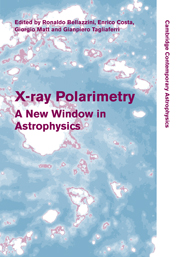Book contents
- Frontmatter
- Contents
- List of contributors
- Preface
- 1 X-ray polarimetry: historical remarks and other considerations
- Part I Polarimetry techniques
- Part II Polarized emission in X-ray sources
- 14 Probing strong gravity effects with X-ray polarimetry
- 15 X-ray polarization from black holes in the thermal state
- 16 Strong-gravity effects acting on polarization from orbiting spots
- 17 Polarization of thermal emission from accreting black holes
- 18 X-ray polarimetry and radio-quiet AGN
- 19 The soft X-ray polarization in obscured AGN
- 20 The polarization of complex X-ray sources
- 21 Polarization of Compton X-rays from jets in AGN
- 22 Polarization of X-ray lines from galaxy clusters and elliptical galaxies
- 23 Polarization characteristics of rotation-powered pulsars
- 24 Polarized X-rays from magnetized neutron stars
- 25 Polarization properties of X-ray millisecond pulsars
- 26 X-ray polarization signatures of neutron stars
- 27 Polarization from the oscillating magnetized accretion torus
- 28 X-ray polarization from accreting white dwarfs and associated systems
- 29 Polarization of pulsar wind nebulae
- 30 X-ray polarization of gamma-ray bursts
- 31 Central engine afterglow from GRBs and the polarization signature
- 32 GRB afterglow polarimetry past, present and future
- 33 Gamma-ray polarimetry with SPI
- 34 INTEGRAL/IBIS observations of the Crab nebula and GRB 041219A polarization
- 35 Fermi results on the origin of high-energy emission in pulsars
- 36 Diagnostics of the evolution of spiral galaxies in a cluster environment
- Part III Future missions
- Author index
- Subject index
28 - X-ray polarization from accreting white dwarfs and associated systems
from Part II - Polarized emission in X-ray sources
Published online by Cambridge University Press: 06 July 2010
- Frontmatter
- Contents
- List of contributors
- Preface
- 1 X-ray polarimetry: historical remarks and other considerations
- Part I Polarimetry techniques
- Part II Polarized emission in X-ray sources
- 14 Probing strong gravity effects with X-ray polarimetry
- 15 X-ray polarization from black holes in the thermal state
- 16 Strong-gravity effects acting on polarization from orbiting spots
- 17 Polarization of thermal emission from accreting black holes
- 18 X-ray polarimetry and radio-quiet AGN
- 19 The soft X-ray polarization in obscured AGN
- 20 The polarization of complex X-ray sources
- 21 Polarization of Compton X-rays from jets in AGN
- 22 Polarization of X-ray lines from galaxy clusters and elliptical galaxies
- 23 Polarization characteristics of rotation-powered pulsars
- 24 Polarized X-rays from magnetized neutron stars
- 25 Polarization properties of X-ray millisecond pulsars
- 26 X-ray polarization signatures of neutron stars
- 27 Polarization from the oscillating magnetized accretion torus
- 28 X-ray polarization from accreting white dwarfs and associated systems
- 29 Polarization of pulsar wind nebulae
- 30 X-ray polarization of gamma-ray bursts
- 31 Central engine afterglow from GRBs and the polarization signature
- 32 GRB afterglow polarimetry past, present and future
- 33 Gamma-ray polarimetry with SPI
- 34 INTEGRAL/IBIS observations of the Crab nebula and GRB 041219A polarization
- 35 Fermi results on the origin of high-energy emission in pulsars
- 36 Diagnostics of the evolution of spiral galaxies in a cluster environment
- Part III Future missions
- Author index
- Subject index
Summary
We present our results of Monte-Carlo simulations of polarized Compton X-rays from magnetic cataclysmic variables, with realistic density, temperature and velocity structures in the accretion flow. Our study has shown that the X-ray linear polarization may reach about 8% for systems with high accretion rates viewed at a high viewing inclination angle. This value is roughly twice the maximum value obtained by previous studies which assumed a cold, static emission region with a uniform density. We also investigate the X-ray polarization properties of ultra-compact double-degenerate binaries for the unipolar-inductor and direct-impact accretor models. Our study has shown negligible X-ray polarization for the unipolar-induction model. However, the direct-impact accretor model may give X-ray polarization levels similar to that predicted for the magnetic cataclysmic variables.
Introduction
Magnetic cataclysmic variables (mCVs) and Ultra-compact double degenerate binaries (UCDs) are potential X-ray polarization sources. The mCVs contain a magnetic white dwarf accreting material from a low-mass, Roche-lobe filling companion star. There are two major types: (i) the AM Herculis binaries (AM Hers, also known as polars) and (ii) the intermediate polars (IPs) (see). In AM Hers, the white-dwarf magnetic field (B ∼ 107 −108 G) is strong enough to lock the whole system into synchronous rotation. It also prohibits the formation of an accretion disk, and the accretion flow is channelled by the magnetic field into the magnetic polar regions of the white dwarf.
- Type
- Chapter
- Information
- X-ray PolarimetryA New Window in Astrophysics, pp. 187 - 194Publisher: Cambridge University PressPrint publication year: 2010
- 1
- Cited by



